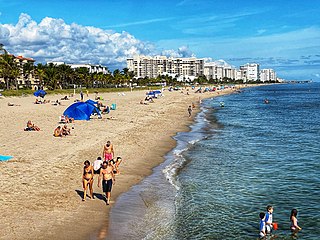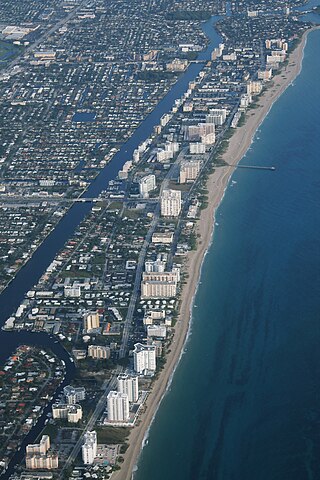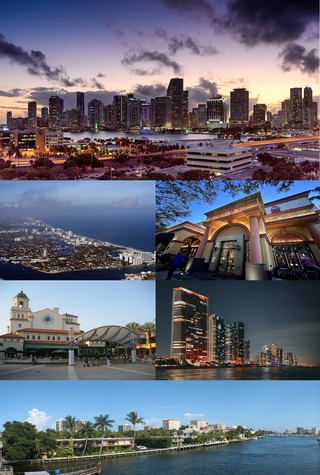
Broward County is a county in the southeastern part of Florida, located in the Miami metropolitan area. It is Florida's second-most populous county after Miami-Dade County and the 17th-most populous in the United States, with over 1,944,375 residents as of the 2020 census. Its county seat and largest city is Fort Lauderdale, which had a population of 182,760 as of 2020.

Hillsboro Beach, officially the Town of Hillsboro Beach, is a town in Broward County, Florida, United States. Its population was 1,875 at the 2010 census. It is part of the Miami metropolitan area, which had 5,564,635 people at the 2010 census.

Lauderdale-by-the-Sea is a town in Broward County, Florida, United States, situated 33 miles north of Miami. As of the 2020 census, the population was 6,198. It is part of the Miami–Fort Lauderdale–West Palm Beach Metropolitan Statistical Area, which was home to 5,564,635 people at the 2010 census.

Lighthouse Point is a suburb of Fort Lauderdale located in Broward County, Florida, United States. The suburb was named for the Hillsboro Inlet Lighthouse, which is located in nearby Hillsboro Beach. As of the 2020 census, the population of Lighthouse Point was 10,486. Lighthouse Point is a part of the Miami metropolitan area, home to 6,166,488 people at the 2020 census.

Pompano Beach is a city in Broward County, Florida, United States. It is located along the coast of the Atlantic Ocean, just north of Fort Lauderdale. The nearby Hillsboro Inlet forms part of the Atlantic Intracoastal Waterway. As of the 2020 census, the city's population was 112,046. Located 36 miles (58 km) north of Miami, it is a principal city in the Miami–Fort Lauderdale–West Palm Beach metropolitan area, which was home to an estimated 6,158,824 people in 2017.

The Miami metropolitan area is the ninth-largest metropolitan statistical area in the United States and the 61st-largest metropolitan area in the world with a 2020 population of 6.138 million people.

Deerfield Beach High School (DBHS) is a public high school in Deerfield Beach, Florida. It is part of the Broward School District and has an enrollment of approximately 2,400.

Hillsboro Inlet Lighthouse is a lighthouse located on the north side of Hillsboro Inlet, midway between Fort Lauderdale and Boca Raton, in Hillsboro Beach, Florida. The light marks the northern limit of the Florida Reef, an underwater coral formation on the lower east coast of the state.

Dixie Highway in Palm Beach and Broward counties carries two segments of the State Road 811 designation by Florida Department of Transportation, as well as the local County Road 811 in southeast Florida. The entire road comprises a section of the Dixie Highway, a National Auto Trail which eventually became a former routing of U.S. Route 1 after the route was shifted east to Federal Highway. One segment of SR 811 is in Broward County and the other is in Palm Beach County, Florida. The segments of SR 811 are supplemented by three shorter segments of CR 811, one of which is unsigned.
Pompano Beach Municipal Stadium was a stadium in Pompano Beach, Florida primarily used for professional and amateur baseball from 1957 until its demolition in 2008. The ballpark was dedicated on March 22, 1957, and held 4,500 people. The stadium was the home of the Washington Senators and Texas Rangers at spring training from 1961 until 1986, multiple minor league clubs, and the Pompano Beach High School baseball team.

The James D. and Alice Butler House, commonly known as the Butler House, is a historic house museum in Deerfield Beach, Florida. It is located at 380 East Hillsboro Boulevard. On July 28, 1995, it was added to the U.S. National Register of Historic Places.

The Bonnet House is a historic home in Fort Lauderdale, Florida, United States. It is located at 900 Birch Road. On July 5, 1984, it was added to the U.S. National Register of Historic Places. It is named after the Bonnet Lily.
Pompano Beach High School is a college-preparatory school located in Pompano Beach, Florida, which instructs grades 9 through 12. Founded in 1928, it is the second oldest high school in the Broward School District.

The Mai-Kai is a Polynesian-themed restaurant and tiki bar in Oakland Park, Florida. It opened to the public on December 28, 1956, and is one of the few "Grand Polynesian Palaces of Tiki" still in operation today. In 2015 it was named the "best tiki bar in the world" by Critiki, an organization of fans of Polynesian pop culture. It is the last restaurant in existence carrying on the traditions of service and serving the original drink recipes of Don the Beachcomber, and has been listed on the National Register of Historic Places.
WBZT is a radio station broadcasting a sports gambling format. Licensed to West Palm Beach, Florida, United States, the station serves the West Palm Beach area. With a synchronous amplifier in Pompano Beach, Florida, they also cover Fort Lauderdale, Florida. The station is currently owned by iHeartMedia, Inc.
South Florida Chamber Maps is a Broward County, Florida print and digital map company. Started in 2011, the company first printed humorous cartoon style maps that showed fun, local things to do in specific Broward County towns and cities including Weston, Coral Springs, Plantation, Pompano Beach, Lauderdale-By-The-Sea and Deerfield Beach. The guides are produced in collaboration with each city's chamber of commerce in order to lend credibility and accuracy to the projects. The maps are considered to be an important part of the northern Broward communities efforts to build regional tourism.

Deerfield Beach Island, also colloquially known as DBI, is an island off the eastern mainland of Boca Raton and Deerfield Beach, Florida, United States.

Funky Buddha Brewery is a large brewery headquartered in Oakland Park, Florida. It began as a small local brewery and is now owned by Constellation Brands, which also owns several wineries.
Blanche Euturpe General Ely was born in Reddick, Florida, the daughter of Deacon John General and Sarah Enock General. Her mother died when she was an infant, and she was raised by her father and her stepmother Amanda General. She graduated from Fessenden Academy in Ocala, and earned a Bachelor of Arts degree at Florida A & M University, and a Master's Degree in Educational Administration and Supervision, Teachers College, Columbia University. She also held a Bachelor of Science in "Life Instructions", from a program jointly sponsored by Florida A&M University and Benedict College.

Timothy "Chaz" Stevens is an American political activist, artist, software developer, and entrepreneur, in Florida. He is active in local politics in Broward County, and has gained national notoriety for his colorful statewide and national advocacy for the separation of church and state.



















